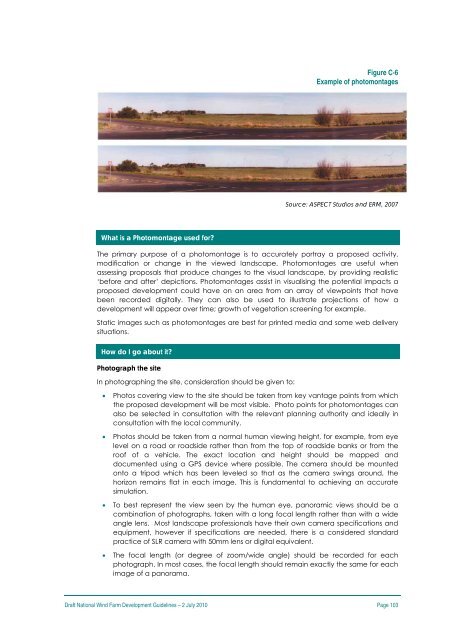Draft National Wind Farm Development Guidelines - July 2010
Draft National Wind Farm Development Guidelines - July 2010
Draft National Wind Farm Development Guidelines - July 2010
You also want an ePaper? Increase the reach of your titles
YUMPU automatically turns print PDFs into web optimized ePapers that Google loves.
Figure C-6<br />
Example of photomontages<br />
Source: ASPECT Studios and ERM, 2007<br />
What is a Photomontage used for<br />
The primary purpose of a photomontage is to accurately portray a proposed activity,<br />
modification or change in the viewed landscape. Photomontages are useful when<br />
assessing proposals that produce changes to the visual landscape, by providing realistic<br />
‘before and after’ depictions. Photomontages assist in visualising the potential impacts a<br />
proposed development could have on an area from an array of viewpoints that have<br />
been recorded digitally. They can also be used to illustrate projections of how a<br />
development will appear over time; growth of vegetation screening for example.<br />
Static images such as photomontages are best for printed media and some web delivery<br />
situations.<br />
How do I go about it<br />
Photograph the site<br />
In photographing the site, consideration should be given to:<br />
• Photos covering view to the site should be taken from key vantage points from which<br />
the proposed development will be most visible. Photo points for photomontages can<br />
also be selected in consultation with the relevant planning authority and ideally in<br />
consultation with the local community.<br />
• Photos should be taken from a normal human viewing height, for example, from eye<br />
level on a road or roadside rather than from the top of roadside banks or from the<br />
roof of a vehicle. The exact location and height should be mapped and<br />
documented using a GPS device where possible. The camera should be mounted<br />
onto a tripod which has been leveled so that as the camera swings around, the<br />
horizon remains flat in each image. This is fundamental to achieving an accurate<br />
simulation.<br />
• To best represent the view seen by the human eye, panoramic views should be a<br />
combination of photographs, taken with a long focal length rather than with a wide<br />
angle lens. Most landscape professionals have their own camera specifications and<br />
equipment, however if specifications are needed, there is a considered standard<br />
practice of SLR camera with 50mm lens or digital equivalent.<br />
• The focal length (or degree of zoom/wide angle) should be recorded for each<br />
photograph. In most cases, the focal length should remain exactly the same for each<br />
image of a panorama.<br />
<strong>Draft</strong> <strong>National</strong> <strong>Wind</strong> <strong>Farm</strong> <strong>Development</strong> <strong>Guidelines</strong> – 2 <strong>July</strong> <strong>2010</strong> Page 103
















